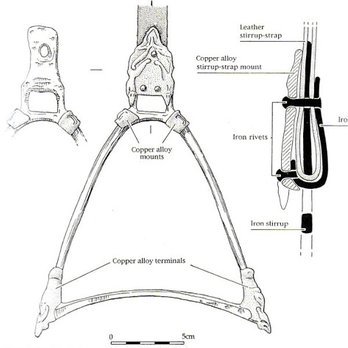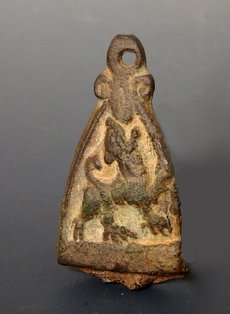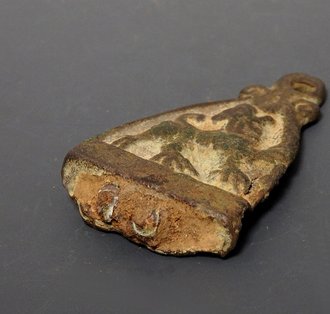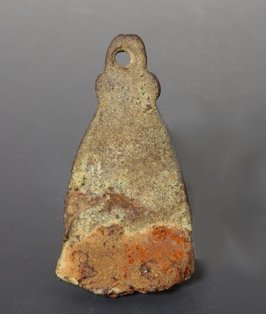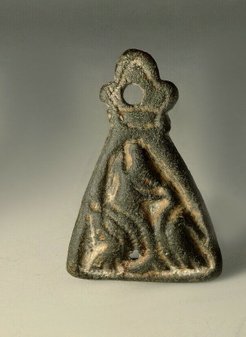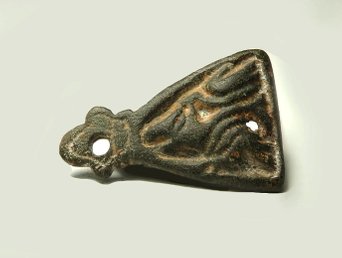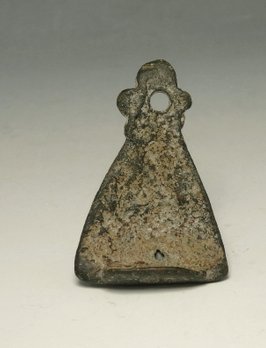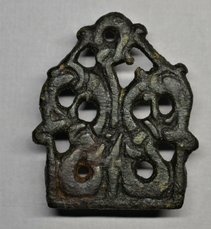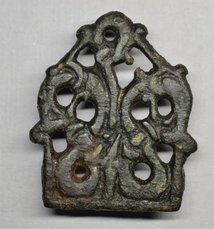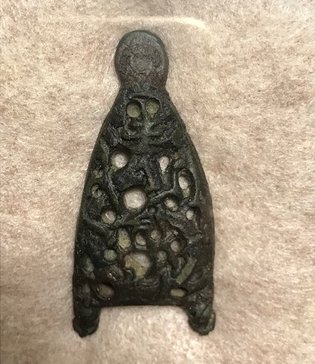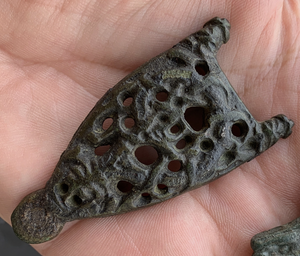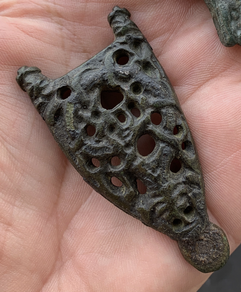Viking or Anglo-Saxon stirrup mounts
On this page various so called stirrup mounts are shown. The stirrup mount their function was to protect the stirrup strap where it looped through the loop at the apex of the iron stirrup. An even more appropiate describtion was minted by P. Robinson in 1992: 'suggesting that they were mounted at the junction between stirrup and strap to provide 'a strap protection device to prevent wear on the stirrup leather'.
All in all the describtion 'stirrup strap mount' would be the appropiate describtion therefore. Stirrup mounts, like the stirrup terminal mounts, are directly attached to the stirrup.
Addressing these stirrup mounts stylisticaly and timewise isn't unambiguous. The late David Williams categorized them as Late Saxon, though with some types included with elements of the Ringerike and Urnes style involved. In the Portable Antiques Scheme a variety of describtions can be found, varying from 'early medieval to medieval', 'late early medieval''Anglo-Scandinavian' and 'late Saxon'. As the Portable Antiques Scheme is stating:
'It is hard to separate types of mounts by period; most straddle early medieval and medieval'.
Even the - shortlived - Anglo-Norman period (1070 - 1140 A.D.) is mentioned when it comes to timepin stirrup mounts. In general one can say that concepts like 'late Saxon', 'Anglo-Scandinavian' and 'Anglo-Norman' of course did not excist in the day and age and are modern minted alterations. And, by the way, what makes a stirrup mount 'Anglo-Scandinavian' or 'Anglo-Norman' anyway. The simple meaning is 'made under the influence of Scandinavians or Normans'. An Anglo-Scandinavian mark can be minted as the stirrup mount has features of a lete viking art style as the Ringerike or Urnes style. As stirrup mount did not made their entrance in England before the first quarter of the 11th century, a variety of styles can be seen. Late Saxon indeed, as the stylistics involved are at the end of a line of developments straight to be addressed originating from the (Anglo) Saxon art style. Anglo-Scandinavian, as - sometimes as marginal or hidden as it seems - Scandinavian art styles from the late Viking Age appear. And finally, Anglo-Norman as it seemingly had produced following the Norman Conquest and had Norman art style outings within. See for example the lions and other griffonlike animals on the border of the Bayeux Tapestry.
The first stirrup strap here is of the so called Group A mounts. It was found by a detectorist around the York area, as stated by the salesman. It is described as a lion-like creature with head turned upwards as if to grasp an object descending from the apex of the frame. The pendant lobe is an Ringerike-inspired device.
The second stirrup mount has a more 'rigor' - if this word excists in English anyway, decoration I would say. It was formely in a collection in the USA and the collector did not provide any find spot. Very well possible this specific type, where a lion or a griffon can be seen had been made after the Norman Conquest. But, of course, I do not know for sure. It would be interesting to see where this specific type of stirrup mount within the Type II spectrum had been found all over England and see how they correspond with the areas the Normans had outspoken military activity and towns they settled. But, then again, horses traveled all over and so did stirrup mounts. To my judgement the second stirrup mount is of a more rarely seen type within the stirrup mounts 'catalogue' until now. The classification and catalogue established in 1997, deserves, alsmost 25 years lear later on, an actualisation for sure. But who will pick up that glove, since David Williams passed away. He left us and the academic world big shoes to fill.
The third stirrup strap mount is seemingly of a less interesting, very weathered nature. But the devil is in the detail(s). In the centre a croslike round figure can be seen. On the left on the edge there is a dragonlike head to be seen with elongated nose, wich is directly derived from the Urnes style. The tendrils to be recognised on the right side of the ear of the dragon head is a Ringerike style characteristic. On the right edge vaguely an animal like winged figure can be seen with elongated snout also. But one can get dazzled: looking at it a second time it has the same dragonlike head with elongated nose to be seen. Dragon head or wing: one can make both out of it. This smart 'hidden figures' casting is a trademark of (late) Viking art. Its precise findspot is unknown, but its previous provenance was a French collection. Once again it would be interesting to research if stirrup (strap) mounts had been found in France also in the area of Normandy, and if this specific type had been found there (also).
If this stirrup strap mount had been made post Viking era, it certainly has late viking art styles within it. Known is, that these art styles did not terminate all of a sudden on art from after the Conquest, so both a late Viking Age as early Anglo-Norman date is possible in my opinion.
The fourth stirrup strap mount is in the Anglo-Scandinavian Urnes style. Entwined dragons or snakes are curling around floral tendrils. De almond shape of the eyes of the animals and the snouts, slightly uplifted at the top, are distinct features of the Urnes style wich excisted from app. 1050 A.D to 1150 A.D. It is a British find.
The fifth stirrup strap mount is of a are type in Urnes style, but at the same time echoïng the predecessing Ringerike style by the execution of the elements and the "hidden" animal head / eyein the middle. It is of a quite rare type and the way it had been preserved is rare also. Its size is also remarkable compared with the other stirrup strap mounts:
As one would say: 'A substantial piece of Viking art!'
Well. I could have been with these stones until after dark, but as my wife wanted to travel on.. well.. I see you again, some day, hogback stones from Gosforth. And if you happen to be there one day, do not forget that monument on the outside...
Further on with the Cumbrian hogbacktour !
In - yes, luckily again in - St. Peter's church in Heysham, there is a truly beautiful hogback stone. The guide told us, it had been studyied by Thor Ewing, a writer, in 2000. in 'Understanding the Heysham hogback' A tenth century sculpted stone monument and its context (link), Thor Ewing tells in detail what he dicovered on the both sides of this hogback stone.
Just being brought in the church as late as the 1970's accompanied with some protest here and there among the church visitors, considered as being a token of old paganism, it had been remarkably nice preserved, and a lot of detail can be seen, still. Truly worthwile a visit.
I had a small debate with the guide in the church if the - zoomorphic, in my opinion - faces on the sides were lions (or hippo's). The guide doubted if the vikings could have known about lions. Well I guess so, concerning the runes on the Ancient Greek lion statue at the Arsenal, Venice. For example. Vikings did travel south..
But when he told me he was doubting the vikings 'discovered' (as the native inhabitants were of course, in the first place) America before Columbus, I decided to rest my case..
One has to know when to start and to end a conversation ..
Just discovered the book in a bookstore written by Geoff Holder - The guide to the mysterious Lake District, I knew there had to be another hogback stone in Lowther, St. Micheal's Church. With a promising image described in the text of 'a naval and a land-based force of shield-bearing vikings above a fish and what might be a coiled sea serpent. On the reverse is a row of female figures with snakes, possibly a representation of the hideous hag Hel'. Wow. If that did not sound as a true pagan promised land ..
Not complaing too much after all we have seen, this visit was the dissapointing one of them all. But if you wife states 'I am happy to have seen them' and I am answering 'Measuring is knowing' and the even more obligate verb 'handling 'if we did not see it at all, we wouldn't have known anything at all of how they were looking' the glass was again half full, at the last day of our journey..
The hogback stone appeared to be just being tolerated within the entrance segment part of the church. As something you never use anymore but you do not throw away - entirely. That sort of feeling emerged when seeing this hogback asylum seekers.. Bed, bath and bread, ás we say in Dutch, but no luxury at all and standing on some outcuts of wood, you would balance the table with at home..
Come on, St. Micheal's Church.. care a bit more of your 'children' !
This hogback stone was moved in the church in 1907. Hogback stones layed partially buried in the churchyard before it was dug up and moved into the church.
The promising depiction of a longship - as certainly can be seen after some studying - see http://vikingminds.co.uk/pages/longship
we have missed !
The stone itself is (157 x 50 x 30 cm) and very worn.
The hogback stones in Cumbria - very diverse in quality, but everyone worth a visit ! Especially on a gloomy day in late October ...
The churches to visit - see photos of resp. St. Andrew's church in Penrith, St. Mary's church in Gosforth, St. Peter's church in Heysham and St. Micheal's church in Lowther.
Did I miss out on another one in Cumbria ? Let me know !
In a next blog I will take you to four - still remaining utterly mysterious- statues 'guarding' the graveyard of St. Andrew's church in Dacre..
For the last blog of October 9th see this link.
References: (as always, links to where the books can be ordered are attached).
Edwards, B.J.N. Vikings in North West England - The artifacts (1998);
Emery, Gordon, CURIOUS CUMBRIA, The Lake District & Beyond: A celebration of Cumbria (2023)
Ewing, T. 'Understanding the Heysham hogback' A tenth century sculpted stone monument and its context ;
Hall, R. Viking Age archaeology in Britain and Ireland (first printed 1990, reprinted with amendments in 1995);
Holder, G. The guide to the mysterious Lake District (2009)
possibly also (as there within the part of Cumbria dealing with Carlisle, the Eden Valley, Barrow-in-Furness, Whitehaven and the west coast is being dealed with)
Holder, G. Paranormal Cumbria (2010)
http://vikingminds.co.uk/pages/longship
